Mushrooms are one of the most perfect ingredients for minimalist, less is more cooking, and these simple roasted hen of the woods / maitake are a great example.
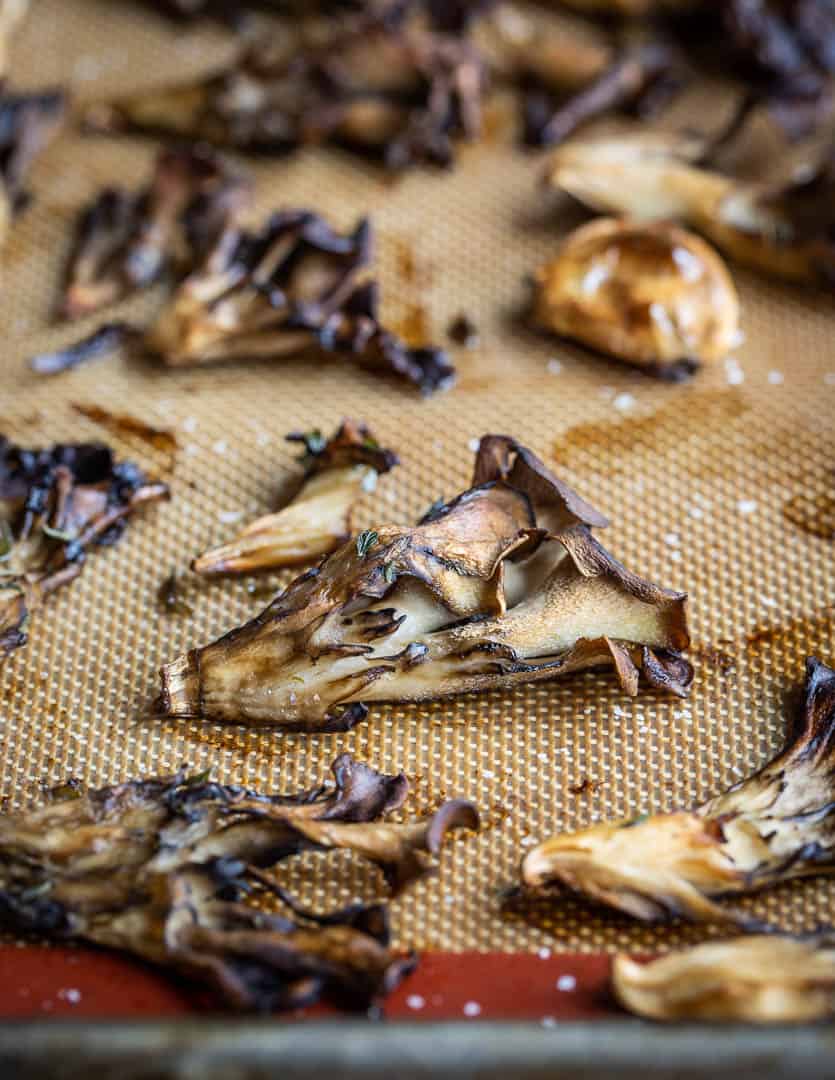
Sure, you can make them into pasta sauce, jerky, and all kinds of things, but probably the simplest, and one of the most delicious hen of the woods recipes to make, is simply to roast them, and eat them fresh from the oven with you're hunting buddy and a cold drink, far away from mosquitos and horseflies.
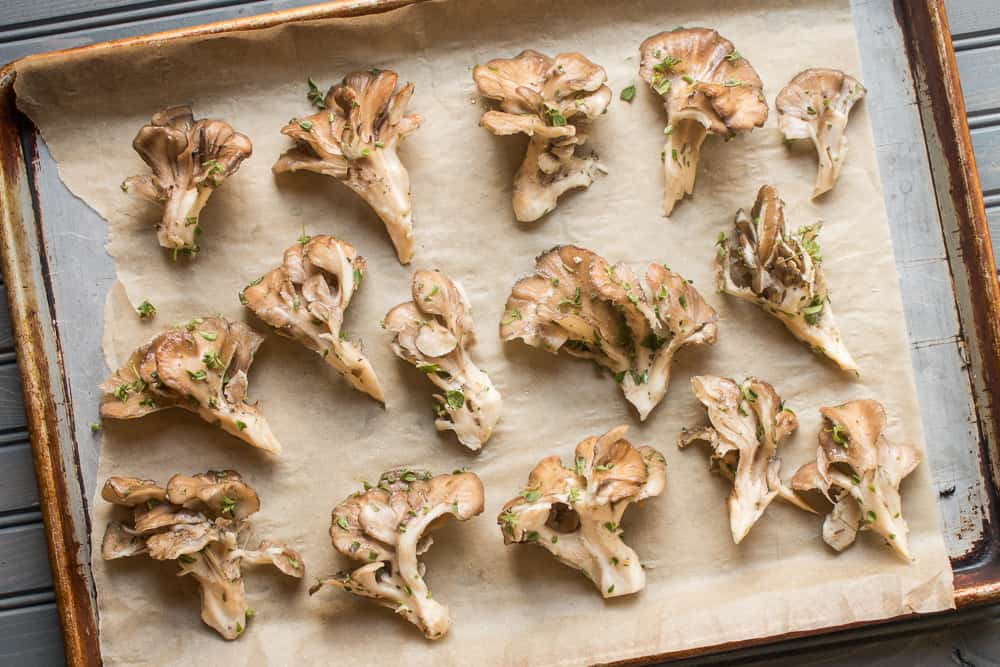
Roasting vs Baking
There's a couple things to mention, mainly that you should imprint the word "roasted" as opposed to "baked" in the recipe here.
Roasting means we're going to use relatively high heat. I say 425F in the recipe below, but simple recipes relying on only a few high quality ingredients can be fussy, so know that you may have to up the heat a bit at the end, or reduce it a little to get crisp edges depending on how well your oven is calibrated.
Use your instincts, but absolutely do not overcrowd the pan since the maitake won't roast properly, and will end up steaming.
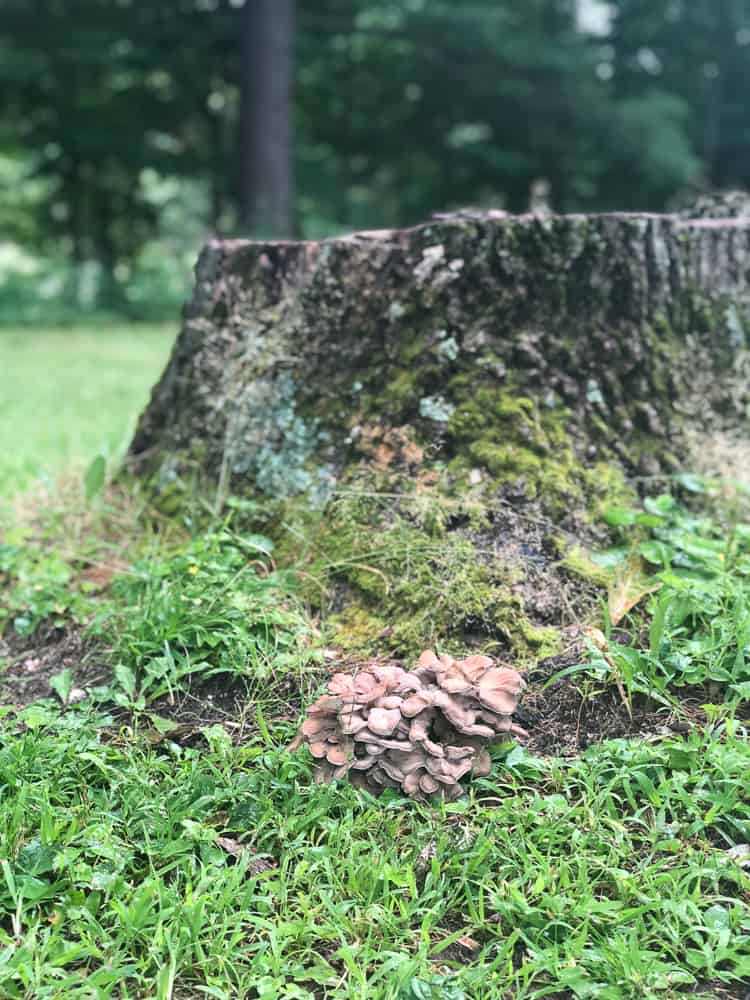
When properly done, you should end up with roasted maitake niblets, perfect for snacking on with a drink, with slightly herbed, crisp edges, but a slightly chewy, tender center.
As the mushrooms cool on the baking sheet, they'll continue to cook, and crisp a bit, so don't worry if yours aren't how you envision them immediately after you take them from the oven.
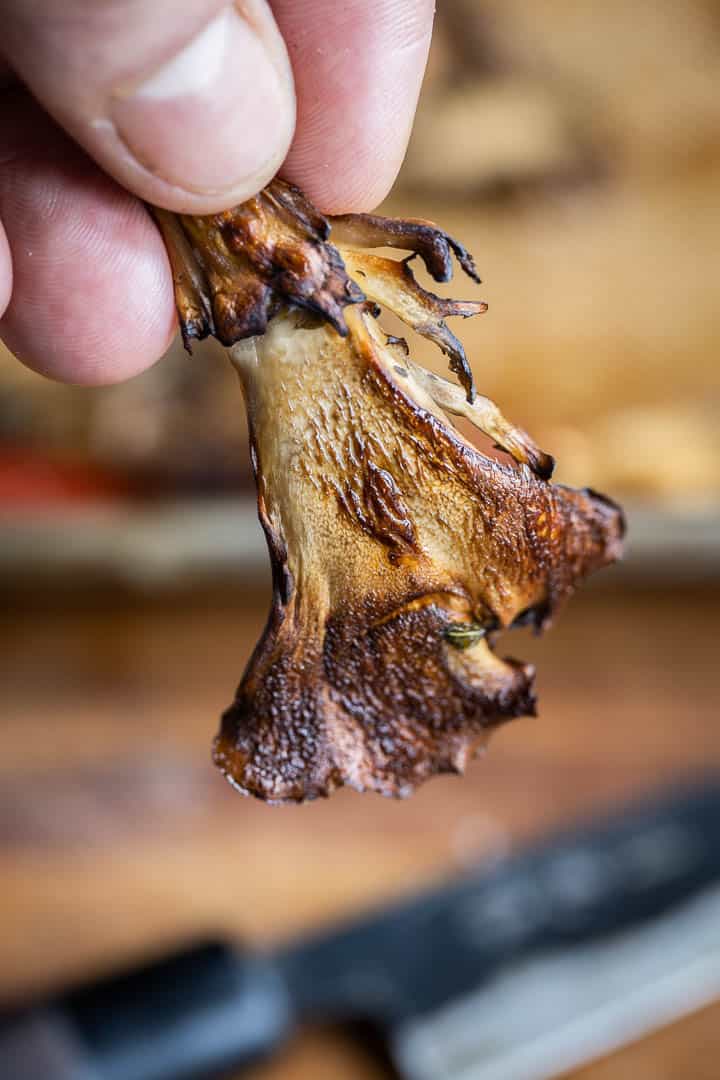
You'll be surprised how fast a pound of hen of the woods mushrooms will disappear, and I can just about guarantee that if you have more than a pound in the fridge, you'll be making more than one tray of maitake.
Making larger batches
You can make this in larger batches than a pound, too, just use multiple baking sheets, or bake in batches. They're best eaten fresh from the oven, still warm.
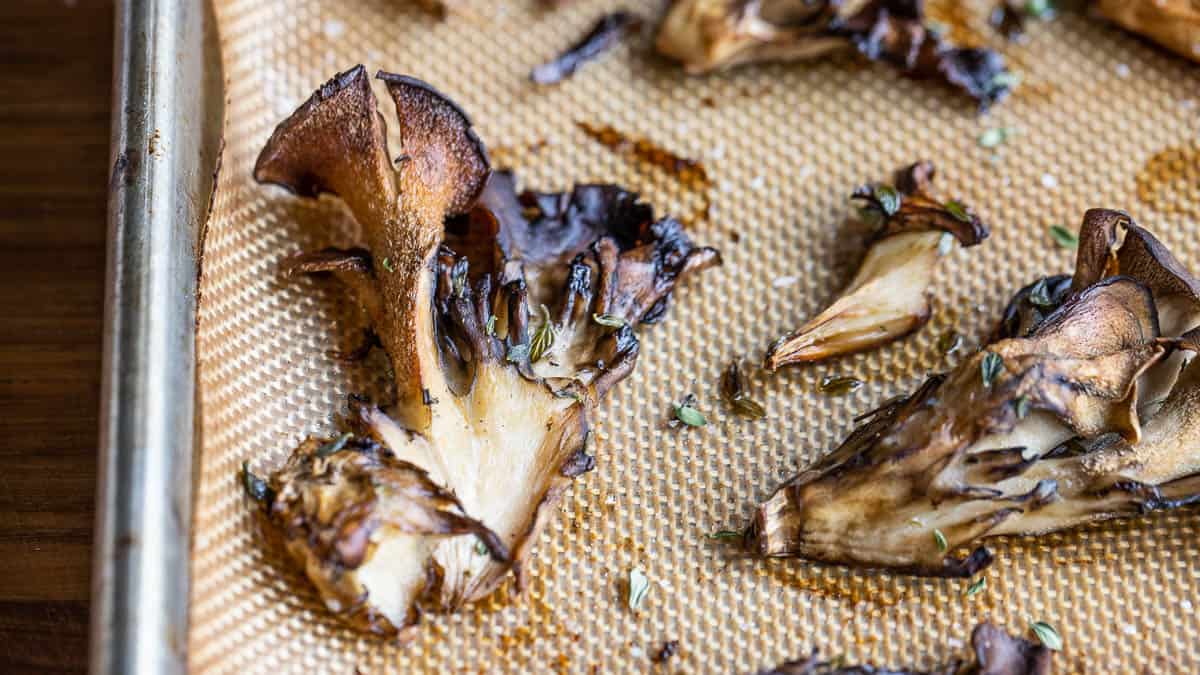
Variations
There's lots of ways to vary this recipe and spice things up if you've tried it and want something slightly different, here's a few ideas:
- Season the mushrooms with curry powder before roasting
- Toss the mushrooms in oil that you've infused with garlic by warming it with a couple crushed cloves.
- Change the herbs up: rosemary, savory and thyme can all be used interchangeably here.
- Make them spicy with a pinch of cayenne.
Wild vs cultivated hens
Some grocery stores now carry hen of the woods. 99% of the time, unless they have a connection with a local farmer or forager, these will be cultivated. Commercially grown hen of the woods can work here, but they won't taste as good as truly wild mushrooms.
This is because the substrate the mushrooms are grown on at a mushroom farm is bland and basic compared to a natural substrate. Just like meat, mushrooms taste like what they eat.
Adding the roasted mushrooms to recipes
When it was fall and I was running a restaurant, it wouldn't be uncommon for us to have a hundred pounds of these mushrooms or more in the cooler.
When we piles of hens, I would often instruct the cooks to bake some of them per the recipe below, but only cooking them until wilted and not browned.
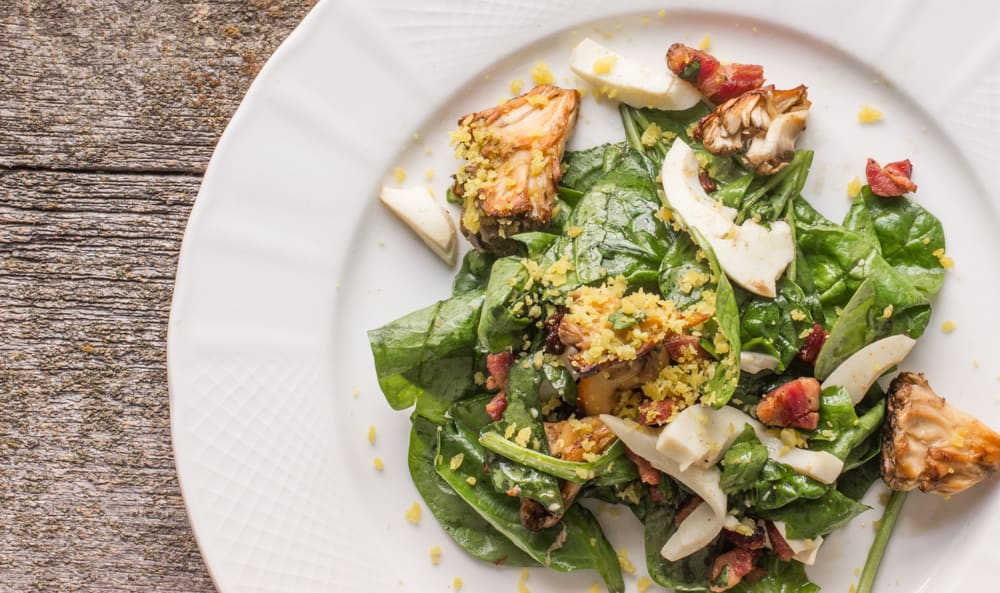
After cooking, cooling and storing, the mushrooms were held in the fridge and quickly heated up before adding to a dish, like a warm spinach salad, vegetarian entrees, steaks, or whatever they were going on, cutting down on the cooking time and ensuring quick service.
If you have a big hen, which is common in the Midwest where I am, par-cooking some wild mushrooms ahead of time makes it easy to just toss them into a pan-which can be nice after a long day in the field when you're tired and don't feel like making something involved.
Related Posts
Hen of the Woods Mushroom Recipes
Roasted Hen of the Woods or Maitake Mushrooms
Equipment
- 1 baking sheet
Ingredients
- 12 Oz hen of the woods Preferably wild, peeled into leaves, cleaned (lightly swished in water and/or brushed as needed if wild/dirty)
- 3 tablespoons flavorless cooking oil
- ¼ teaspoon kosher salt plus an extra sprinkle
- 1 teaspoon Chopped fresh thyme, rosemary, or sage dried thyme is an ok substitute, but not rosemary as it will burn
- 6-7 cracks of the pepper mill or to taste
- 2-3 cloves garlic, peeled and crushed with a knife
Instructions
- Toss the pieces of hen of the woods (press them between paper towels to weep water if you had to rinse them first) with all ingredients.If you have cultivated hen of the woods, do this very gently as most are quite fragile.
- Spread out on a baking sheet lined with parchment or a silicon mat, and bake in a preheated 425 oven for 25-35 minutes (rotating 180 degrees half way through if your oven heats unevenly) until the mushrooms are crisp around the edges, but still slightly tender in the center.
- Cultivated mushrooms may take a bit longer as they typically contain more water. Wild hens, especially those picked in a dry spell, will cook quicker.
- Remove the mushrooms and allow to cool on the baking sheet until you can handle them, then eat.

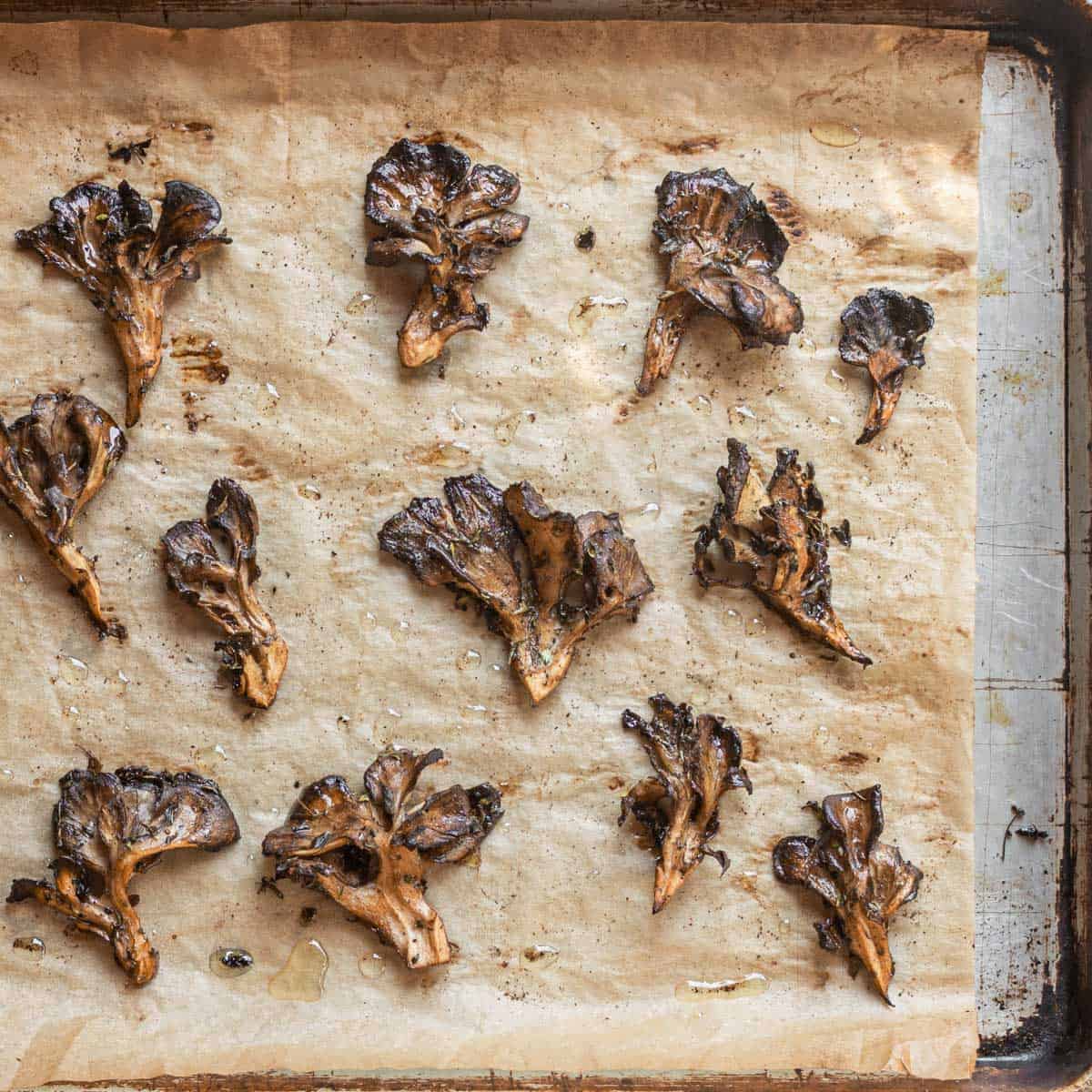
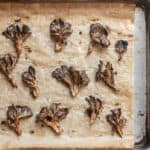
LaRae
Yum!
wolfie
There is one tree in the woods near us where H-O-W annually emerge around the base of the tree to yield 5 or 6 large clumps. This year the weather was misty and most of the clumps were soggy. I gave up trying to air-dry them. What should I have done? I will roast the dry clump that somehow survived, probably shielded by a large rock next to the dirt.
Alan Bergo
Hello. As long as the mushrooms are clean you can cook the water off with a dry saute, then add oil afterwards.
Sophia
Fabulous, if you can find these mushrooms. Tossed in butter, lemon, pine nuts, and parmigiana reggiano, and served over cheesy polenta. Super filling and delicious. I love roasted mushrooms, especially the brown, crispy edges.
David Gibbs
I like the option of toasted sesame oil and sprinkled with sesame seeds black and white. And don't forget dipping sauces.. the possibilities are limitless.
Alan Bergo
Great ideas.
Chris Provost
I have some leftover large chunks of my hen base that I separated from the fronds while making this recipe. Is there anything I can do with them? Maybe chop them up for use in a duxelle or dehydrate them and use them for soup stock? Thanks for your website and recipes. I recently got into foraging and I'm really digging this information!
Alan Bergo
Cut them into soup chunks, dry them for broth. Saute as a regular mushroom, lots of things you can do, assuming it's nice and clean.
Marlene Handly-Stack
I found a lovely large batch of fresh my turkey today. I used to use a food dehydrator and would use them throughout the winter for soup stews anything I can think of. My question is I no longer have the food dehydrator can someone tell me the best way to keep these for your usage out of a best prepare them?
Alan Bergo
Steam and freeze them.
Marlene Handly Stack
2022 in Northeastern United States has started off to a great season. I had a food dehydrator and used it a lot. Throwing them in stews, soupsectetra . Someone needed it worse than I didn't no longer have the food dehydrator so my question is I have a slow of wonderful fresh my doggy pic today what is the best way to preserve them besides dehydrating them? I have been doing this for many years and find it a good hike for an old lady like me. Thank you so kindly for any suggestions or any other recipes that my mind hasn't came up with.
Pam
I was given about 20 lbs of hen of the woods from my friends yard. I’m defiantly going to try these recipes!
Erik
Great base recipe that can be changed for your own tastes and whatever spices/herbs you like. Thanks for the inspiration.
Alan Bergo
Glad it worked for you Erik.
4stringdude
Thanks for this delicious recipe. I found a large Hen yesterday. This is the first recipe I have tried and it is a keeper. We had is with a wild rice mix and it was a perfect meal
Alan Bergo
Glad it worked for you. Wild rice is the perfect compliment.
Kathy B.
Mmm, I think I’m going to try sautéing the rest of mine. We roasted half of it and I was underwhelmed. Maybe I should have been more generous with the oil.
Alan Bergo
Kathy, there's a few things to consider here, and I wouldn't give up on it just yet. If you underseasoned it, didn't use the herbs, or your oven is not calibrated correctly it could all affect the finished product.
John B
I've prepared hen in a variety of ways, but this is by far the best! The crisp and savory notes of the herbs, garlic and salt really make this an amazing fall appetizer. Pair it with a märzen or pumpkin ale and you have a perfect autumn delicacy!
Alan Bergo
Agreed.
Chrstrr
Fall 2021 on the east coast is damp! Say you find WAY more maitake than you can eat at one time, and you roast some. Other than snacking on them fresh out of the oven (YUMMM!!), any other suggestions for how to use them?
Alan Bergo
Oh yeah! I used to have my cooks roast them at a lower temp and then we’d hold them for service, warming them up with butter and lemon and putting on cuts of meat, heating them up in broth, or, one of my favorites, adding to salads fresh out the oven with bacon vinaigrette and chopped boiled egg.
ilona
When you say flavorless cooking oil, does that mean *not* olive oil, or does it mean oil that is not infused with a flavor?
I consider plain olive oil to have some flavor. I plan to make this recipe and I just want to be sure....this is the first time I've run across "flavorless cooking oil". Thanks!
Alan Bergo
Ilona, you may not have seen it before, but "flavorless" cooking oil is commonly used in culinary parlance. What it means, basically, is use an oil with a high smoke point. Your plain olive oil, as long as it is not extra virgin, will work fine. Extra virgin will probably smoke a bit, but if you cut it with another oil like grapeseed, etc, it can be used for this. Mix the oils 50/50.
Kay
Usually that just refers to a more neutral-tasting oil with a high smoke point like canola, vegetable, etc. Olive oil could work in some cases but in general even the non-extra virgin kinds will have too low a smoke point for cooking at 425 degrees and could potentially lend an acrid flavor as well as undesired transformation to trans fats. Olive oil is not generally considered a flavorless oil in the aforementioned parlance, though I guess you could use lighter olive oil in a pinch. Hope that helps!
Mark
i see 375 in the comments and 425 in the recipe itself for roasting temp?
Alan Bergo
A typo. Thanks for catching that. 425 F is what you want.
Rose
Excellent results for my first time cooking Hen of the Woods. I threw in a sprinkle of smoked paprika as well. Delicious and simple.
lisa
Thanks for your beautiful recipes using hen of the woods, it's awful easy to suddenly have a WHOLE LOT of it! This is so simple and sounds delicious, a good way to get more hen down my gullet. I might try it with a squirt of lemon, too.
Alan Bergo
Welcome, and lemon is great here.
Brenda Bellinger
Bought a gorgeous maitake at our local farmer's market. The vendor said to "roast" it. Went online for a little more detail and found your site. Followed your recipe and the results were delicious! Will definitely make this again. Thank you!
Alan Bergo
Glad it worked for you Brenda.